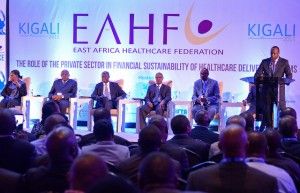Private sector health innovations are playing a growing and complementary role to the government in East Africa.
Delegates from 43 countries gathered in Kigali, Rwanda on May 17th for a 3-day event to discuss the role of the private health sector in East Africa. Hosted by the East Africa Healthcare Federation (EAHF), an organization representing private health sector stakeholders across the region, delegates represented major providers, insurers, research and consultant organizations, and the government. The theme of this year’s conference was “The role of the private sector in financial sustainability of healthcare delivery systems.” Each delegate at the event was a healthcare innovator in their own right and there is an increasingly clear role for private sector players in the health sector in East Africa. Topics that gathered the most attention at the conference included: quality care; low-cost, high-volume service delivery models; information and communication technologies; enabling policy and investor environments, and innovations in healthcare financing with many impressive initiatives emerging in each of these areas.
Conversations at the EAHF event and additional meetings with major players in the healthcare innovation support ecosystem and budding health entrepreneurs in Rwanda provided enlightening context around these themes:
- Quality of care is an important differentiator and plays an important role in ensuring financial sustainability of health enterprises. Patients and communities are demanding better quality of care and “voting with their feet” by frequenting providers deemed to provide quality services. Innovations in Healthcare participated in a panel where we shared three case studies of innovators in our network that work on quality improvement from diverse lenses, including Penda Health, LifeNet International and Clínicas del Azúcar. LifeNet provides clinical and management training to improve quality of care in faith-based clinics, which has contributed to improved financial returns for their franchise clinics. Quality of care is a differentiator that Penda integrates into its value proposition to their clients. The case study we presented showcased the investment made in educational and organizational interventions to promote adherence to clinical quality guidelines. The Clínicas del Azúcar example we presented illustrated how highly personalized care can be a cost-saver in a fixed-cost membership fee model and result in higher quality, appropriate care that has the potential to lead to better health outcomes.
- There is a need to scale more low-cost, high-volume service delivery models. While much progress has been made in increasing access to care for underserved populations in the region, it is now time to scale what works. One such example is One Family Health (OFH). Under a public-private partnership agreement, OFH is working with the Ministry of Health of Rwanda to expand access to primary care through a franchised network of nurse-run clinics. They have achieved remarkable progress. To date, OFH has opened more than 90 heath posts and served more than 600,000 patients across 11 districts. Lessons learned from such initiatives should be applied to other models and initiatives across the region. Some ideas coming through at the EAHF event included the need for disruptive innovations to make healthcare systems better serve Africa’s masses and the need to address risks associated with investment in innovative care delivery models. Participants shared the varied ways in which the private sector is innovating across the health value chain to increase availability of affordable healthcare across the region.
- Information and communication technologies are becoming increasingly core to the functionality of health systems in the region. Intentional investments in the ICT sector by regional governments, including Rwanda, make the region a hot bed for good ideas. Understanding how best to implement these good ideas given the behavior change requirements (both of the end user and the implementing organization) will be key for these innovations to achieve widespread scale and impact. We believe more knowledge sharing and dialogue around implementation challenges can help grow the best ideas.
- Don’t underestimate the power of an enabling policy and investor environment. Rwanda has led the region in putting necessary political structures in place that help organize and standardize the health sector and its major players. This has also resulted in a friendly investor environment in the country, as investors know how to engage with the public and private sector for maximum impact. More such structures are needed for the region to garner the type of long-term, strategic investments that will create lasting change. A Ministers’ panel at the EAHF conference highlighted how different countries in the region are collaborating with the private sector to improve free movement of goods, capital, and people.
Finally, health financing plays a critical role in increasing access to health services for the vast majority of the population. Rwanda again is leading the region in demand-side financing with the highest insurance coverage rate in the region, due in large part to their social insurance scheme Mutuelle de Santé. Across the region similar models could be implemented and access further increased by establishing and engaging adequate supply side health providers to respond to increased demand. Examples of health protection products designed to reach the working poor are in the works by many in the region including our innovator, MicroEnsure.
To learn more about how to engage with the Innovations in Healthcare East Africa team and how you can learn more about emerging trends in healthcare innovation in the region, please contact Patricia Odero (patricia.odero@duke.edu) or Sylvia Sable (sylvia.sable@duke.edu).

